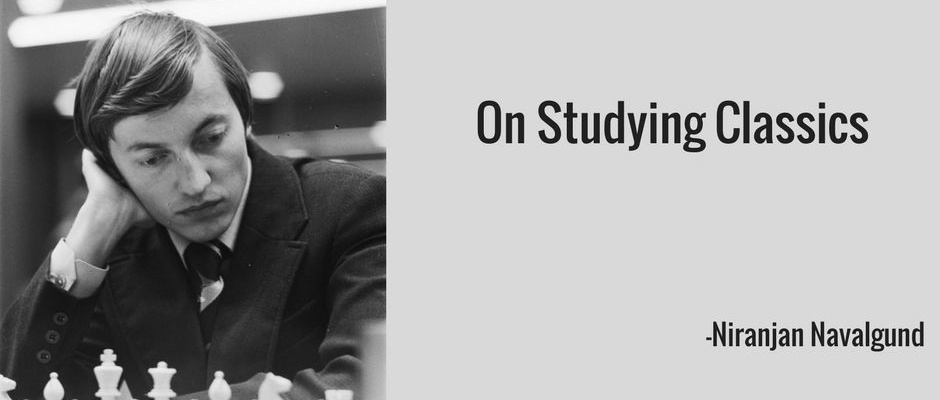On Studying Classics
Studying classics is emphasized by every top player, isn’t it? I have heard the phrase ‘Study the classics’ many times. In order to understand the nuances of any opening, it helps to study the classical old games as they reveal the graph and status of the opening. In the initial years of chess study, I didn’t know HOW to study the games. I would blindly play over the games and fret a little for not having understood much from them. I assumed that I had to grow as a player to understand and appreciate the beauty of these games.
After a few years, I participated and worked with other chess players and found out that there are a lot of ways to benefit from the classics. I’m sharing two common ways of studying the classics in this article:
A)Playing through the games on the board to develop a feeling for the position.
I have used this method, but one cannot rely on this alone. You setup the board and pieces, write down the game and play the moves on the board. Some players use this method to get a feel for the positions. It doesn’t involve lot of calculations, but just feeling and understanding the possible pawn breaks, superior and inferior pawn constructions, piece exchanges and piece placements, possible tactical themes and so on. After going through the games, note down the themes that played a major role in the games. This is very useful if you want to develop a general understanding.
I’m sharing five games of Karpov here. The games can be useful if you want to understand the nuances of minority attack.
Game 2 : The key theme in this game is the weak pawn on c6 and the beautiful post for the knight on c5. These two elements were enough for white to build pressure
Game 3 : This game shows a lot about exchanges. Which piece to exchange? Observe that white willingly exchanged the dark squared bishops in the beginning and cleverly declined the exchange of the light squared bishops in the middlegame.
Game 4 : In this game, e3-e4 break opened new avenues for white. Karpov also demonstrated good handling of Opposite Colored bishops.
B)Guessing the Moves/ Calculating in Critical Positions
This is more about thinking in specifics, solving specific problems or working on a specific subject by extracting a lesson from a classical game. For example, if you wanted to study positions with material imbalances, then you could consider studying the games of Mikhail Tal. Take his game and try to put yourself in his shoes and think in critical positions. What would you do here? Compare your move and try to grasp the ideas and motifs.
Mihail Marin’s Learning from the Legends is an excellent book that covers the games and positions of great players with a specific theme attributed to them.
Let us go through the game using the second method:
Karpov vs Beliavsky, 1991
White to play
It is a good idea to pause before an exchange of a piece. White deliberately exchanges his bishop for a knight to achieve b2-b4. This also tells us that Karpov prioritizes minority attack associated with b2-b4 over keeping the bishop on g5.
- Bxf6 Bxf6 13.b4 Ne6
Now, it is time to arrange rooks. But, which rook to choose and where to place it?
Consider the following candidates:
a) Rfb1 b)Rab1 c)Rfd1 d)Rfe1
Karpov played 14.Rfd1 making it clear that he wants to play e3-e4 soon:
14.Rfd1 a6 15.Bf1 Qd6 16.a3 Bd8 17.e4
17…dxe4 18.Nxe4 Qf4 19.Re1 Bb6 20.Qc3 Rd8 21.g3 Qh6 22.Rad1 Qg7
How to proceed further?
I paused here because this is a critical position. White has several options here:
A)23.Re3 supporting the Queen on c3 b)23.d5!? getting rid of the IQP c)23.Nc5 preventing …Bd7
Re3 is perfectly possible; 23.d5 requires some calculation – 23.d5 cxd5 24.Nf6+ Kh8 25. Nxd5 Qxc3 26.Nxc3 Bd7 the the position is balanced.
Karpov played 23.Nc5!
and the game continued:
23… a5 24.Qb3 axb4 25.axb4 Nc7 26.Bc4 Nd5 27.Kg2 Qf6 28.Ne5 Kg7 29.h4 Ra7
Where is the weakness? If you have found it, then the move is easy to find as well.
30.Rd3 Karpov has employed the rook lift many times in his life.
Bf5 31.Rf3 h5 32.Ncd7 Qd6 33.Nxb6 Nxb6
White to play:
Is 34.Nxf7 winning?
Yes, 34.Nxf7! Qxd4 35.Nxd8 Qxd8 36.Qc3+ Kh6 37.Rxf5 tears open the black’s shield
Karpov played 34.Bxf7 which wins as well. But, 34.Nxf7 would have got the point home quickly.
34…Nd5 35.Bxd5 Qxd5 36.Qxd5 Rxd5 37.Rf4 Ra4 38.f3 Rxb4 39.g4 hxg4 40.fxg4 Rb2+ 41.Kg3 Be6 42.Nxg6 Rb3+ 43.Kf2 Rb2+ 44.Kg3 Rb3+ 45.Kf2 Rb2+ 46.Kg1 Rd6 47.Nf8 Bf7 48.Re7 Kxf8 49.Rexf7+ Kg8 50.h5 Re6 51.Rf8+ Kg7 52.R4f7+ Kh6 53.Rf6+ Rxf6 54.Rxf6+ Kg5 55.Rg6+ Kf4 56.h6 Kg3 57.Kf1 Kf3 58.Ke1 Ke3 59.Kd1 Kd3 60.Kc1 Rc2+ 61.Kb1 Rg2 62.Rg5 Rh2
1–0
I hope the article has given you an overview on how to study the classics! Happy studying them 🙂

